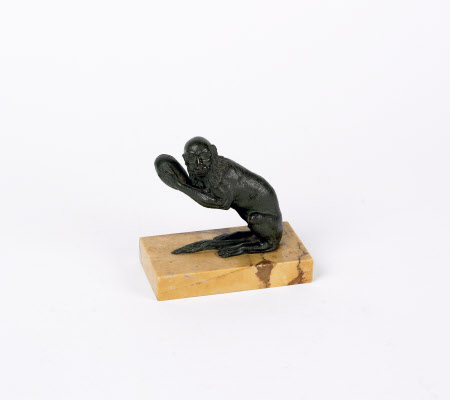Statuette of a macaque monkey
after Francesco Antonio Franzoni (1734 - 1818)
Category
Art / Sculpture
Date
c. 1800 - 1850
Materials
Bronze
Place of origin
Rome
Order this imageCollection
The Argory, County Armagh
NT 565249
Summary
Sculpture, bronze; a seated macaque monkey; after Francesco Antonio Franzoni (1734-1818), Rome; c. 1800-50. A small bronze reduction of a marble sculpture in the Sala degli Animali of the Museo Pio Clementino in the Vatican, Rome. The sculpture in Rome was acquired by the Vatican museums as a Roman antiquity, but was in fact almost entirely the creation of Franzoni, the chief restorer for the Vatican museums in the later eighteenth century.
Full description
A small bronze statuette of a seated bearded monkey, its tail on the ground between its legs, looking to its left towards the spectator, holding in its hands a pumpkin. Mounted on a giallo antico marble base. The monkey seems to be a member of the macaque family, possibly the long-tailed macaque, a species from South-East Asia, but which was certainly not especially rare in Europe in the late eighteenth-century. The bronze at the Argory is a small reduction of a marble figure of a macaque (Gonzalez-Palacios 2013, no. 55), one of some 175 sculptures of animals or featuring animals, assembled in the latter decades of the eighteenth century in the Sala degli Animali (Hall of the Animals) in the Museo Pio Clementino in the Vatican. The little bronze figure, made for the tourist trade, is an accurate reproduction of the Vatican marble, except that it omits the ground, scattered with other fruits, on which the monkey is seated. Most of the sculptures in the Sala degli Animali were restored and/or supplied by Francesco Antonio Franzoni (1734-1818), who worked as the chief restorer for the Vatican in the latter decades of the eighteenth century. In some cases, for example the Vatican biga or chariot (NT 565233), the proportion of genuine Roman elements was so small that the resulting sculpture was effectively his creation. This was also the case with the sculpture of the monkey, which Franzoni delivered to the Vatican in October 1792. When he billed for the sculpture, he described it as antique and made from marble from Senegal, whilst he also specified that the object held by ther monkey was a pumpkin. However, it has long been recognised that the sculpture is almost entirely the work of Franzoni. It is not known whether the original sculpture was modelled from a specific animal. Although it is all but certain that neither knew anything of the other’s work, there are intriguing parallels between Franzoni’s highly naturalistic figure of the macaque monkey in the Vatican, and the contemporary painting by George Stubbs (1724-1806) of a long-tailed macaque, possibly the same species, versions of which are in a private collection (dated 1774; Egerton 1984, no. 85) and in the Walker Art Gallery, Liverpool (dated 1798). Jeremy Warren November 2022
Provenance
By descent; Walter McGeough Bond (1908-86), by whom given to the National Trust in 1979.
Makers and roles
after Francesco Antonio Franzoni (1734 - 1818), sculptor
References
Gonzalez-Palacios 2013: Alvar González-Palacios, Il Serraglio di Pietra. La Sala degli Animali in Vaticano, Città del Vaticano 2013, pp. 102, 217, no. 55. Egerton 1984: Judy Egerton, George Stubbs, 1724-1806, exh. cat., Tate Gallery, London 1984
